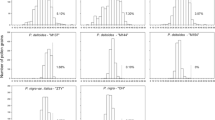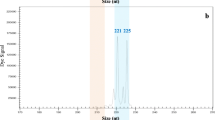Abstract
Hybrids (2n = 2x = 24) from crosses between Group Tuberosum haploids (2n = 2x = 24) and 24-chromosome, wild species must be fertile and produce 2n gametes if they are to be used in breeding schemes involving sexual polyploidization. Male fertility of the 2x hybrids depends primarily on the species parent. Hybrids involvingS. berthaultii, S. chacoense, S. kurtzianum, S. spegazzinii, andS. tarijense as parents are male fertile. The haploid parents are male sterile, so the species not only contribute genetic diversity and desirable traits, but also genes necessary for male fertility.S. infundibuliforme, S. raphanifolium, andS. sanctae-rosae parents produced male sterile hybrid progeny, while use ofS. boliviense, S. bukasovii, S. canasense, S. microdontum, andS. sparsipilum results in families containing both fertile and sterile plants. Sterility may be due to interactions between Tuberosum cytoplasm and dominant nuclear genes from the species. Genetic male sterility and environmental conditions may also be responsible for low pollen stainability in some hybrids. Many fertile, 2x hybrids produce 2n pollen. Selection for 2n pollen in the species is fast and efficient, but meiotic analysis is required in male sterile haploids. Fortunately, selection in the species parent alone results in a large number of 2n pollen-producing hybrids. These 2x hybrids have been used to generate tetraploids via 4x × 2x crosses.
Resumen
Los híbridos (2n = 2x = 24) derivados de cruzas entre haploides del Grupo Tuberosum (2n = 2x = 24) y especies silvestres de 24 chromosomas deben ser fértiles y deben producir gametos 2n si ellos han de ser usados en esquemas de majoramiento que incluyen la poliploidización sexual. La fertilidad masculina de los hibridos 2x depende, primariamente, de la especie silvestre progenitora. Los hibridos que incluyeronS. berthaultii, S. chacoense, S. kurtzianum, S. spegazzinii yS. tarijense como progenitores presentaron fertilidad masculina. Los progenitores haploides presentan esterilidad masculina, de manera que las especies silvestres no sólo contribuyeron con diversidad genética y características deseables, pero también con genes necesarios para la fertilidad masculina. Los progenitoresS. infundibuliforme, S. raphanifolium, y S.sanctae-rosae produjeron progenie hibrida con esterilidad masculina, mientras que el uso deS. boliviense, S. bukasovii, S. canasense, S. microdontum, yS. sparsipilum producen familias que contienen plantas tanto fértiles como estériles. La esterilidad podria deberse a la interacción entre el citoplasma de Tuberosum y genes dominantes nucleares de las especies silvestres. La esterilidad genética masculina y condiciones ambientales pueden también ser responsables por el bajo porcentaje de polen coloreado en ciertos hibridos. Muchos hibridos 2x fértiles producen polen 2n. La selección por polen 2n en las especies silvestres es rápida y eficiente, pero análisis en la meiosis es requerida en haploides con esterilidad masculina. Afortunádamente, una selección sólo en las especies silvestres resulta en un gran número de híbridos que producen polen 2n. Estos hibridos 2x han sido usados para producir tetraploides através de cruzas 4x1 2x.
Similar content being viewed by others
Literature cited
Arndt, G.C. 1985. Pollen fertility in relation to open pollinated true seed production. Am Potato J (In press).
Buck, R.W., Jr. 1960. Male sterility in interspecific hybridsof Solarium. J Hered 512:13–14.
Camadro, E.L. and S.J. Peloquin. 1980. The occurrence and frequency of 2n pollen in three diploid Solanums from northwest Argentina. Theor Appl Genet 56:11–15.
Carroll, C.P. 1975. The inheritance and expression of sterility in hybrids of dihaploid and cultivated diploid potatoes. Genetica 45:149–162.
Chase, S.S. 1963. Analytic breeding inSolanum tuberosum L.-a scheme utilizing parthe-notes and other diploid stocks. Can J Genet Cytol 5:359–363.
DeJong, H., G.C.C. Tai, W.A. Russell, G.R. Johnston and K.G. Proudfoot. 1981. Yield potential and genotype-environment interactions of tetraploid-diploid (4x-2x) potato hybrids. Am Potato J 58:191–199.
den Nijs, T.P. 1977. 2n gametes in potato species: occurrence, genetic basis and function in sexual polyploidization. Ph.D. Thesis, University of Wisconsin. 135p.
Dionne, L.A. 1961. Cytoplasmic sterility in derivatives ofSolanum demissum. Am Potato J 38:117–120.
Gill, B.S., L.N.W. Kam-Morgan and J.F. Shepard. 1985. An apparent meiotic mutation in a mesophyll cell protoclone of the ‘Russet Burbank’ potato. J Hered 76:17–20.
Grun, P. 1970. Cytoplasmic sterilities that separate the cultivated potato from its putative diploid ancestors. Evolution 24:750–758.
Grun, P., M. Aubertin and A. Radlow. 1962. Multiple differentiation of plasmons of diploid species of Solanum. Genetics 47:1321–1333.
Hanneman, R.E. and S.J. Peloquin. 1981. Genetic-cytoplasmic male sterility in progeny of 4x-2x crosses in cultivated potatoes. Theor Appl Genet 59:53–55.
Hawkes, J.G. 1945. The indigenous American potatoes and their value in plant-breeding. Emp J Exp Agric 13:11–40.
Hawkes, J.G. 1958. Significance of wild species and primitive forms for potato breeding. Euphytica 7:257–270.
Hermundstad, S.A. and S.J. Peloquin. 1985. Germplasm enhancement with potato haploids. J Hered (In press).
Lamm, R. 1941. Varying cytological behavior in reciprocalSolanum crosses. Hereditas 27:202–208.
Lamm, R. 1953. Investigations on some tuber-bearingSolanum hybrids. Hereditas 39:97–112.
Leue, E.F. 1983. The use of haploids, 2n gametes, and the topiary mutant in the adaptation of wildSolanum germplasm and its incorporation into Tuberosum. Ph.D. Thesis, University of Wisconsin. 189p.
Liberal, M.T. 1966. Fertilidade de populacoes em F1 e F2, envolvendo haploides deSolanum tuberosum L. e diversas especies diploides. Pesq Agropec Bras 1:165–172.
Mendiburu, A.O. and S.J. Peloquin. 1977. The significance of 2n gametes in potato breeding. Theor Appl Genet 49:53–61.
Mok, D.W.S. and S.J. Peloquin. 1975. Breeding value of 2n pollen (diplandroids) in tetraploid × diploid crosses in potatoes. Theor Appl Genet 46:307–314.
Oppong, A. 1981. The occurrence and frequency of 2n gametes inSolanum species from Peru and Bolivia in relation to polyploid evolution and germplasm transfer. Ph.D. Thesis, University of Wisconsin. 132p.
Peloquin, S.J. and M. Iwanaga. 1982. Origin and evolution of cultivated tetraploid potatoes via 2n gametes. Theor Appl Genet 61:161–169.
Quinn, A.A., D.W.S. Mok and S.J. Peloquin. 1974. Distribution and significance of diplandroids among the diploid Solanums. Am Potato J 51:16–21.
Ross, R.W., S.J. Peloquin and R.W. Hougas. 1964. Fertility of hybrids fromSolanum phureja and haploid S.tuberosum matings. Eur Potato J 7:81–89.
Rowe, P.R. 1969. Nature, distribution, and use of diversity in the tuber-bearingSolanum species. Econ Bot 23:330–338.
Souter, E.W., J.C. Dawe and S.J. Peloquin. 1980. 2n pollen formation via parallel spindles in the potato cultivar Sebago. Am Potato J 57:449–455.
Author information
Authors and Affiliations
Additional information
Paper No. 2802 from the Laboratory of Genetics. Research supported by College of Agricultural and Life Sciences; International Potato Center; SEA, USDA CRGO 84-CRCR-1-1389; and Frito-Lay, Inc.
Rights and permissions
About this article
Cite this article
Hermundstad, S.A., Peloquin, S.J. Male fertility and 2n pollen production in haploid-wild species hybrids. American Potato Journal 62, 479–487 (1985). https://doi.org/10.1007/BF02854521
Accepted:
Issue Date:
DOI: https://doi.org/10.1007/BF02854521




